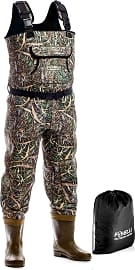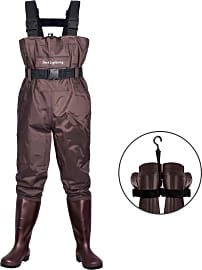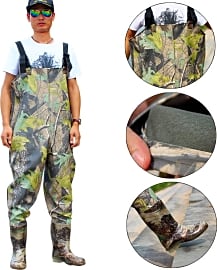The 10 Best Fishing Waders

This wiki has been updated 36 times since it was first published in October of 2016. If you plan on venturing into the water to cast a line, make sure you’re equipped with a pair of these fishing waders. Whether the river is ankle deep or approaching chest height, they should keep you warm and dry as you attempt to land a big one. They come in a range of sizes and styles for men, women and children, and many can be used for hunting as well. When users buy our independently chosen editorial choices, we may earn commissions to help fund the Wiki.
Editor's Notes
December 16, 2019:
Four of the existing items on this list — the Grundens Highlander, Webetop Overalls, Oakiwear Children and Orvis Sonic Convertible — were no longer available and had to be removed. We also decided to eliminate the Redington Sonic Pro due to significant leaking issues.
To replace those, we added several new models — some include thick rubber boots attached to the bottom of the legs, while others feature integrated neoprene booties, giving users a variety of options. We also inserted the Tidewe Children, which is specifically designed for kids, to replace the Oakiwear Children.
The Dark Lightning Fly include a boot hanger, a useful little add-on that comes in handy for drying out all your damp gear after a long outing on the water. Users cite the Foxelli Duck as a great value; in addition to reliable durability and effective insulation, they come with a carrying case and a waterproof phone bag.
Special Honors
Caperlan WDS-3L Warm-weather fishermen will appreciate the breathability of these versatile waders, which should help keep the perspiration to a minimum during a day out in the sun. They’re lightweight but rugged, with special reinforcements built into the areas around the knees and shins. caperlan.co
Comfort Breeds Success
Few things can drive away your desire to fish like being unbearably cold and wet.
When I used to go fishing in the murky waters of our local river as a kid, my adventurous spirit would at times guide me waist-deep into the running water in pursuit of elusive bass and catfish. I never wore fishing waders. Even if my father had instructed me to wear them, which he didn't (parent of the year, he apparently was not), I almost surely would have disregarded his advice. Shorts and flip flops were my universal uniform; some mildly polluted river water wasn’t going to change that.
Knowing what I know now, I would’ve asked my dad to pony up for a solid pair of waders and slid them on every time I went down to the river. For most anglers, fishing is a leisure pastime. It’s about relaxing, spending time with family and friends, connecting with nature, and that addictive tug of a fish on the line of your favorite fishing pole. Few things can drive away your desire to fish like being unbearably cold and wet.
That’s why remaining dry and comfortable is such an essential component of extended fishing sessions. This is especially important for fly fisherman, since they spend all of their time in the water instead of on a boat or the shoreline. A lot of fly fishing is done up in the mountains, where the air and water can become rather cold. To prevent the submerged parts of your body from freezing and going numb, most waders are lined and insulated.
Spending hours at a time in the water can be hazardous. In extreme cases, immersing your feet underwater for too long can cause a condition known as trench foot. Furthermore, you’re often unable to see the surface you’re walking on as you wade, which makes you susceptible to slipping and falling. It's important to consider the soles of the wader boots you're using and the level of grip they provide.
A Fit For All Anglers
Speaking of wading boots, you’ll have two primary types of footwear to choose from: bootfoot and stockingfoot. A bootfoot model offers the convenience of being integrated right into the waders. If you opt for the stockingfoot option, you must purchase and put the boots on separately. Bootfoot models are simple, easy to take on and off, and convenient to clean. Stockingfoot waders are flexible, provide better ankle support, and can be equipped with metal studs on the soles for enhanced grip. It's a simple matter of preference.
Stockingfoot waders are flexible, provide better ankle support, and can be equipped with metal studs on the soles for enhanced grip.
Each distinct style of wader is designed for a specific type of fishing situation. For more audacious souls who require maximum coverage, chest waders are probably the way to go. As you’ve likely guessed, they offer protection up to your chest. These are useful for deep and unpredictable waters where you may encounter surprise drop-offs or floating debris.
Waist high waders are similar to a pair of pants, leaving your torso exposed. This style is ideal when chest waders are excessive, as they offer ample protection for aggressive stream wading and climbing in and out of boats. Plus, they’re far more comfortable in warm weather. Essentially heavy-duty tall boots, hip waders are perfect for shallow creeks and streams on hot summer days. They’re also the least expensive and most versatile.
You should also consider the material. If you prefer to do your angling during the spring or summer, breathable waders are a nice choice. They’re vented, resilient, and easy to wear with a tee shirt and shorts. During the cooler months, the insulating quality of neoprene waders can be very attractive. While not breathable, they’re highly durable. Nylon waders are a flexible, inexpensive option.
Keep in mind, certain materials have undesirable qualities as well. For example, a movement to restrict the use of felt-soled waders and wading boots to prevent the spread of invasive species has been gaining momentum since 2009. To date, several states have enacted legislation to ban these. If you’re considering felt-soled waders, make sure to check whether they’ve been banned in your state before purchasing them.
Why Bother With Wading?
Yes, boat fishing allows you to cover the maximum amount of water, and fishing from the shore can be supremely relaxing. Wading, however, is unique in that it draws you into the very habitat you seek to penetrate. For example, enormous fish can be found in shallow areas during their spawn, but sometimes these hotspots are remote and difficult to access. With the right wading gear and strategy, you can have a field day at these places.
With the right wading gear and strategy, you can have a field day at these places.
Some species, such as walleyes, prefer running water in precise locations near the inlets of streams. Since the fast-moving water makes it very tough to position a boat or accurately cast from shore, wading emerges as the only viable option to really get into these fish. Wading in this situation can be loads of fun, but be careful – this is an instance where safety and vigilance are of the utmost importance. Don’t enter the water if the current is too strong, and make sure your boots provide reliable grip for the type of bottom you’re dealing with.
Of course, wading isn’t the easiest method. Maybe you’re reluctant to do it because it requires you to leave behind the convenience of having your tackle and gear within reach at all times. It’s certainly a valid gripe, but it’s one that can be addressed with a quality fishing backpack. Using one of these, everything you require to land the big one is literally on your person. Most fishing backpacks are waterproof, as well.
As a fisherman, you’re part of an important industry. In today’s era of social media addiction, you’re far more likely to see a young person stumbling down the street glued to an iPhone than carrying a fishing pole to the creek. And while you may only consider it a personal passion, recreational fishermen in America make a significant impact on the economies in which they live and fish. They support hundreds of thousands of jobs and generate billions of dollars in retail sales and tourism revenue in states across the nation.















